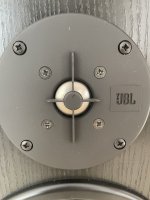Hi All,
I've noticed that in many metal dome tweeters there is a "dispersion guide" but not in many soft dome tweeters, is there any reason for that? why in metal dome tweeters and not in soft dome tweeters?
Doesn't it limit the tweeter horizontal and vertical axis beaming which affects wide soundstaging?
As far as I know tweeters beam narrower beam in comparison to mids or woofers so why limit wide beaming even more?
Thanks
I've noticed that in many metal dome tweeters there is a "dispersion guide" but not in many soft dome tweeters, is there any reason for that? why in metal dome tweeters and not in soft dome tweeters?
Doesn't it limit the tweeter horizontal and vertical axis beaming which affects wide soundstaging?
As far as I know tweeters beam narrower beam in comparison to mids or woofers so why limit wide beaming even more?
Thanks
Attachments
That thing is to damp out the intense high frequency resonance that these metal dome have. So, not there for dispersion. It will however be a difference in dispersion if taken away most certainly.
//
//
For all I know these are phase shields. At very high frequencies, on-axis sound from the center of the dome gets more and more out of phase compared to the sound from the rim. This results in phase cancellations at -again- very high frequencies on axis. The phase shield introduces a longer pathway for the sound from the center of the dome, thus getting it back in phase with that from the rim of the dome.
Yes, it's supposed to make dispersion smoother. But some are better than others... Dimple dome is another way to attempt it. Protection from little fingers and cleaning wipes is guaranteed!
If you take a tall drinking glass with parallel walls and hit the galls with a eating fork, you will hear it ring. A lot. If you take a tube the fits closely inside the glass but yet don't touch any glass surface and hit it again with the fork you will hear only a "tock".... this is (also?) the effect that is wanted from the cap.
//
//
I like the grids with glued-on phase shields the way Seas does'em!Yes, it's supposed to make dispersion smoother. But some are better than others... Dimple dome is another way to attempt it. Protection from little fingers and cleaning wipes is guaranteed!
http://www.seas.no/index.php?option...cle&id=57:h1147-06-27tbcg&catid=45&Itemid=462
Metal grille with a sticker inside, difficult to see in pics.
I've had those in a design by Zaph http://www.zaphaudio.com/audio-speaker17.html but I didn't have any measurement system then.
Replaced it with MarkK design in same boxes https://www.diyaudio.com/community/threads/mark-ks-er18dxt.351264/
Metal grille with a sticker inside, difficult to see in pics.
I've had those in a design by Zaph http://www.zaphaudio.com/audio-speaker17.html but I didn't have any measurement system then.
Replaced it with MarkK design in same boxes https://www.diyaudio.com/community/threads/mark-ks-er18dxt.351264/
At very high frequencies, soft domes begin to behave like a ring radiator. Basically the diaphragm is lossy enough that the tip of the dome isn't moving in sync with the base of the dome.
You'll notice this with nearly all soft-ish diaphragm materials, including paper.
Rigid diaphragms don't do this; even at 20khz, the tip of the dome is moving in unison with the base of the dome.

The phase plug introduces a tiny bit of a delay, so that the sound radiated from the tip of the dome is in-phase with the sound radiated from the base of the dome. For instance, 20khz is 17 millimeters long. So when the tip of the dome is just 6-8mm closer to you than the edge of the dome, the radiation from the tip will be out-of-phase with the radiation from the base of the dome.
So the phase plug adds a delay.
The bigger that the dome is, the bigger the phase plug needs to be. The smaller the dome is, the smaller the phase plug needs to be.
I made this thread here with some 3D printed phase plugs that illustrates how this works:
https://www.diyaudio.com/community/threads/diy-compression-drivers.317125/
You'll notice this with nearly all soft-ish diaphragm materials, including paper.
Rigid diaphragms don't do this; even at 20khz, the tip of the dome is moving in unison with the base of the dome.
The phase plug introduces a tiny bit of a delay, so that the sound radiated from the tip of the dome is in-phase with the sound radiated from the base of the dome. For instance, 20khz is 17 millimeters long. So when the tip of the dome is just 6-8mm closer to you than the edge of the dome, the radiation from the tip will be out-of-phase with the radiation from the base of the dome.
So the phase plug adds a delay.
The bigger that the dome is, the bigger the phase plug needs to be. The smaller the dome is, the smaller the phase plug needs to be.
I made this thread here with some 3D printed phase plugs that illustrates how this works:
https://www.diyaudio.com/community/threads/diy-compression-drivers.317125/
Thank you guys for your efforts, comments and the interesting information, learned something today🙂
The phase shield prevents the on-axis response from drooping at the top octave, but in the process it actually makes the dispersion worse. At least it did on mine.Yes, it's supposed to make dispersion smoother.
- Home
- Loudspeakers
- Multi-Way
- Metal dome tweeter "dispersion guide"...or maybe I'm using the wrong term
